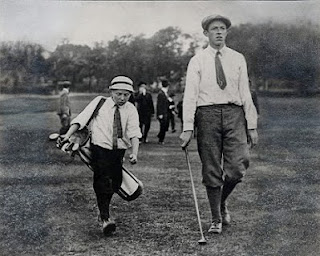The Greatest Golf Match Ever Played?
The photo at right shows Francis Ouimet at the 1913 U.S. Open, and beside him his caddie, 10-year-old Edie Lowery.
That tournament, that year, was the subject of the book by Mark Frost called The Greatest Game Ever Played,and the movie of the same name. It detailed the stunning victory by the previously unknown amateur Ouimet over the titanic Harry Vardon and highly accomplished Ted Ray in a playoff to win the U.S. Open.
Mark Frost now has a new book, this one entitled, The Match: The Day the Game of Golf Changed Forever. The book tout I ran across begins this way:
In the year 1956, Eddie Lowery, a wealthy supporter of amateur golf, bet George Coleman, an equally important figure in the sport, that two of his car salesmen could beat any other two players in a game of golf.
Eddie Lowery. Could this Eddie Lowery - the wealthy car salesman in California in 1956 - be the same as that Eddie Lowery - the 10-year-old caddie to Francis Ouimet in Massachussetts in 1913?
Yes, they are one and same. Lowery grew up to become a successful businessman, eventually settling in California and running a string of car dealerships. Along the way he always was a stalwart supporter of amateur golf.
One of the ways he supported top amateur golfers in California was to give them jobs at his dealerships.
Frost's new book, The Match, details a four-ball match at Cypress Point in 1956 that grew out of Lowery's boast to George Coleman, another wealthy businessman who owned a home near Pebble Beach, where the Bing Crosby Pro-Am was always played, was a member at Cypress Point, and who was friends with many of the top professionals.
Lowery boasted that he had two amateurs working for him who could beat any other two golfers that Coleman could come up with. Coleman replied, "Wanna bet?" According to one report, they first wagered $50,000, although by the time the match actually took place only $50 was at stake.
But what makes the match the stuff of legend is the identity of the golfers involved. The two golfers Lowery had working for him were Ken Venturi, a future 14-time PGA Tour winner and major champion; and Harvie Ward, a multiple U.S. Amateur champion and Walker Cupper who also won the British Amateur.
And the "any two golfers" Coleman came up with? Ben Hogan and Byron Nelson. Pretty good team, eh?
Hogan and Nelson (who had been retired from full-time competitive golf for 10 years by this point) were in town for the Pebble Beach Pro-Am. Hogan made a tee time at Pebble Beach for the morning of the challenge match to distract everyone from the real site of the match, Cypress Point. Then the four golfers met in battle at Cypress. Although by the time they reached the homestretch, word had filtered out and quite a crowd had gathered.
According to a San Francisco Chronicle article written last year following Nelson's death, Golf Magazine once referred to the four-ball as "the greatest match ever played." The Chronicle article reports:
Neither side was more than 1-up, they halved only three holes with pars and they collectively made 27 birdies and one eagle.
An article on the Golf Channel's Web site passes on these details:
Hogan and Venturi matched birdies on the par-3, 15th. When the players reached the famous 235-yard, par-3, 16th hole, the professionals were still clinging to their one-shot lead. On this day, the 16th, which sits like Atlantis amidst the rocks and crashing waves, was playing dead into a harsh Pacific wind. Nelson and Ward were both forced to use drivers to reach the putting surface. In a testament to their prowess, their tee shots set up birdie putts that both men would convert. The 17th hole was halved, setting up the short, 342-yard, par-4, 18th hole as the deciding factor. Venturi and Ward's only chance was for another birdie, hoping that the professionals would score a par, at best. Venturi negotiated his wedge approach shot to within 12 feet of the cup. In a microcosm of the day, Hogan hit his approach just inside of Venturi's. Venturi then displayed nerves of steel when he smoothly rolled his ball into the hole. Hogan surveyed his putt with the intensity that earned him the nickname of "The Hawk."
Past tellings of the story always include disagreements with each other, and Frost's book should serve as the definitive account. Case in point: Hogan's reaction to that final putt.
According to the Golf Channel article, "As he settled over the putt, it is reported that Hogan growled through clenched teeth, 'I'm not about to be tied by two ***damn amateurs.' "
But that's now how Ken Venturi remembers it, as reported in the Chronicle article:
As Venturi recalled, "Byron said, 'C'mon, Ben, knock this in and we can win.' Hogan said, 'I'm not going to lose to two amateurs,' and winked at me. He knocked his putt in right on top of mine and they won 1-up. ...
There's an old saying, "The older I get, the better I was." Events such as this one tend to grow in grandeur over the years, because there's no film of it, no contemporaneous reports. Even most of the people who saw any of the match are gone. But regardless of whether this match really qualifies as "the greatest ever played," or even just one of the greatest, Frost's book should be a fun read.

